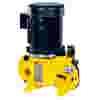How does a streaming current detector work?
A streaming current detector is equipped with a reciprocating plunger in which a water sample is continuously passed through. Charged particles adhere to the plunger and cylinder surfaces. The SCD contains electrodes to induce a current such that ionic charges are transported by fluid velocity and then measured at the electrodes. The charge is measured in 10-9 Amps which is then amplified and processed by the SCD. The ultimate output of the SCD is a 4-20 mA analog output signal that can control the speed of a metering pump to increase or decrease the chemical dosage rate to maintain process control.
What are the different applications in which a streaming current detector would be used?
Streaming current detectors can be used in any treatment process in which charged ions can be used to determine a chemical dose rate. Surface water treatment plants are some of the most prevalent users of Streaming Current Detectors to help optimize coagulant dose rates. In fact, some jurisdictions have regulations in place that require usage of streaming current detectors as the resultant water quality is significantly improved with lower costs compared to traditional methods. SCDs are typically used in Influent clarification, Reverse Osmosis, High Purity, Waste Water Treatment clarification and sludge dewatering.









